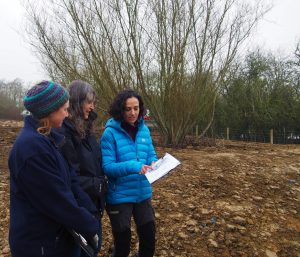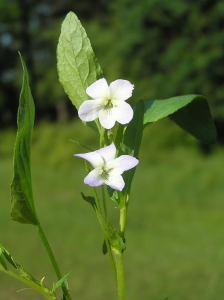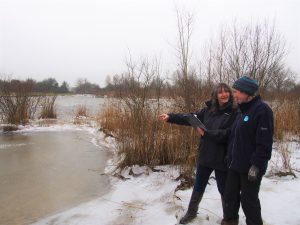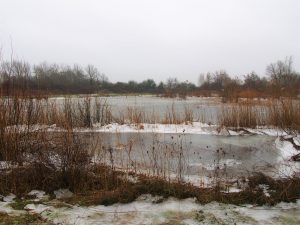New wildlife habitats will restore historic Oxfordshire wetlands
27th January 2023
More of Oxfordshire’s historic wetlands will be restored to their former glory, thanks to a new collaborative project between national wildlife conservation charity Freshwater Habitats Trust and Thames Water.
The initiative, which is also funded by the Government’s Green Recovery Challenge Fund, is the latest step in Freshwater Habitats Trust’s ambitious project to build a national network of high-quality freshwater and wetland habitats for wildlife. This focuses initially on Oxfordshire, where the charity is based.

Paola Perez and Penny Williams (Freshwater Habitats Trust) look at plans at the Farmoor reservoir site with Hanna Jenkins (Thames Water).
The new partnership project with Thames Water will create a mosaic of floodplain wetland habitats in meadows next to Farmoor Reservoir. This includes eight new ponds and pools spread across a three hectare site. When the work is completed in January 2023 the waterbodies will complement other floodplain restoration work through the Thames Valley, enhancing habitats for species such as water vole and otters, as well as amphibians, invertebrates, including dragonflies and water beetles, and rare and threatened plants.
Freshwater Habitats Trust has been involved in creating new ponds at the Farmoor Reservoir site for more than 30 years. The first group of 25 ponds was created on Pinkhill Meadow next to the River Thames in 1990. Funded by Thames Water and the Environment Agency, it was used to trial Freshwater Habitats Trust’s new ideas about how to design wildlfe-rich ponds.
The design proved successful and the Pinkhill ponds are now exceptionally rich in biodiversity, including being home to around 80 wetland plant species, as well as Water Vole, Otter and a strong Common Toad community.
With more than 30 years of monitoring data, Pinkhill Meadow is also unique in Europe because of the detailed evidence it provides of how to create ponds that deliver real benefits for wildlife. This learning is still going on and the team is now looking at benefits provided by the small herd of cattle, which Thames Water recently introduced to the meadow. These include controlling rampant plants, while also creating muddy patches next to the water’s edge, which gives rare species a chance to thrive.
 Petr Filippov via Wikimedia Commons
Petr Filippov via Wikimedia Commons
The team is also introducing some of Oxfordshire’s rarest wetland plants to the site, including Fen Violet, Creeping Marshwort and Flat-sedge. These plants have been grown from seed and nurtured by local volunteers, through Freshwater Habitats Trust’s GroWet project. Once plentiful in the British countryside and across Oxfordshire, these species are now in decline. Some are so rare they are at risk of becoming extinct in England without the sort of help being offered through GroWet.
To protect wildlife, Pinkhill Meadow is closed to the public. However, some of the new ponds are in areas that are open to the public, while others will have wheelchair access and dipping platforms so they can be used by schools and other groups to enjoy and learn from.
Freshwater Habitats Trust Technical Director Penny Williams designed the original ponds at Pinkhill Meadow and has since carried out regular surveys to monitor plant and animal species living at the site. She has led on the designs for these new habitats and is working with the team to deliver them.
 Penny Williams (Freshwater Habitats Trust) and Hanna Jenkins (Thames Water) at one of the new habitats near Farmoor reservoir
Penny Williams (Freshwater Habitats Trust) and Hanna Jenkins (Thames Water) at one of the new habitats near Farmoor reservoir
Penny said: “It’s really rewarding to use the knowledge that we’ve built up over the last 30 years to make these new wetland mosaic habitats even better for wildlife. Building out from Pinkhill will not only attract new species to the site, but will enhance the environment for the huge number of plant and animal species that already live here. This collaborative project with Thames Water will also extend the wildlife corridor that Freshwater Habitats Trust and other conservation organisations are creating through the Thames Valley.
“Oxfordshire can be proud of its wetland heritage. Through projects like this, we are restoring some of our historic habitats and helping to reverse the rapid decline in freshwater wildlife.”
Richard Aylard, Sustainability Director at Thames Water, added: “We’re delighted to be working alongside Freshwater Habitats Trust to restore wetland habitats in meadows at Farmoor Reservoir. Thames Water is committed to improving the local environment and believes this partnership will create a natural habitat where wildlife can thrive.”
The initiative is part of Freshwater Habitats Trust’s Building Oxfordshire’s Freshwater Network project, funded through the Government’s Green Recovery Challenge Fund. The project is connecting wetland habitats and creating a network of clean water habitats to help wetland species to thrive.
 Part of the new floodplain wetland mosaic habitat near Farmoor reservoir
Part of the new floodplain wetland mosaic habitat near Farmoor reservoir
